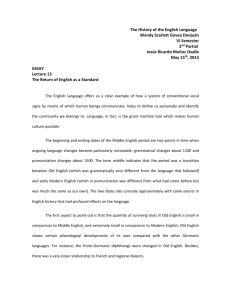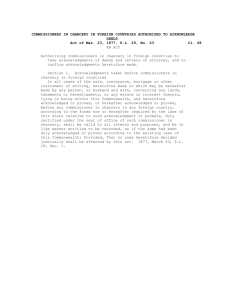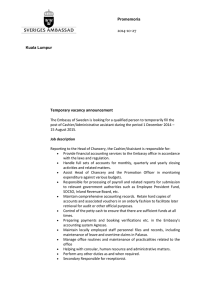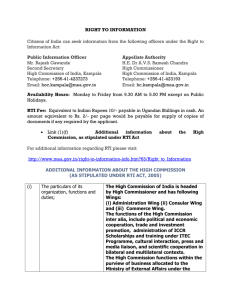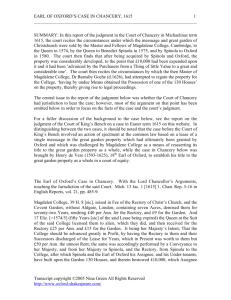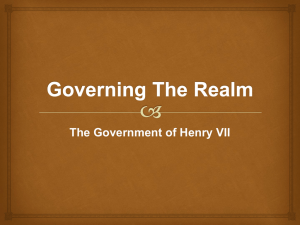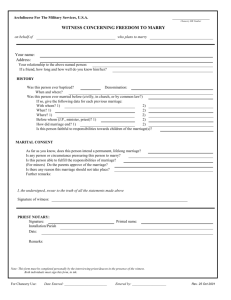OCT 10 1961
advertisement
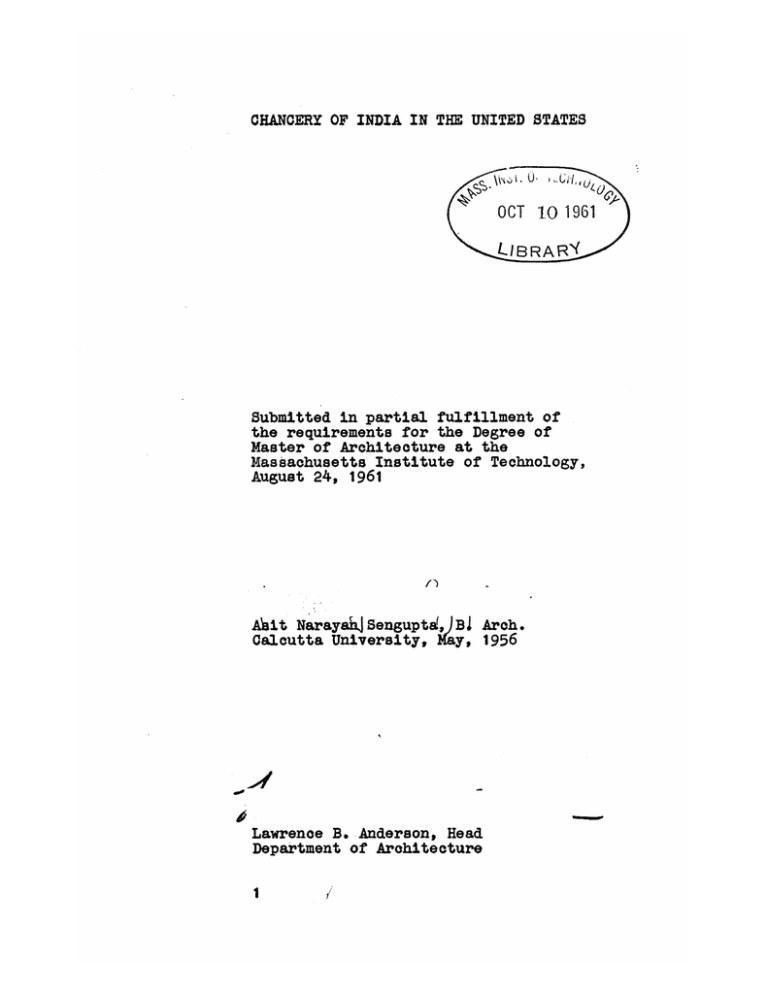
CHANCERY OF INDIA IN THE UNITED STATES OCT 10 1961 E.18B R A R"' Submitted in partial fulfillment of the requirements for the Degree of Master of Architecture at the Massachusetts Institute of Technology, August 24, 1961 Ait Narayah) Sengupta(,jBJ Arch. Calcutta University, May, 1956 000 Lawrence B. Anderson, Head Department of Architecture 1 CHANCERY OF INDIA IN THE UNITED STATES THE ABSTRACT A. Title. Chancery of India in the United States B. Name of Author. Asit Narayan Sengupta C. Submitted for the degree of Master of Architecture in the Department of Architecture on August 24, 1961 Housed in a building, originally built for residential use, the Indian Chancery in Washington, D. C., faces the problems of inadequacy of natural light, view and more critically, space, and the lack of visual and spatial qualities that it should have to be a successful meeting place, for conducting the business between the two nations. The Chancery officials feel that the Government of India will consider building a new Chancery before long. This thesis proposes such a Chancery, which symbolically, is a part of India abroad, on a site between the Massachusetts Avenue and the Rock Creek and Potomac Parkway in the traditional diplomatic enclave on the North-West section of the city. The Program was developed in cooperation with the officials of the Chancery and is assumed to become a reality, in course of five years from now. 2 . 317 West 75th. Street New York 23, New York Pietro Belluschi Dean, School of Architecture and Planning, M. I. T. Cambridge 39, Massachusetts Dear Dean Belluschi, In partial fulfillment of the requirements for the Degree of Master of Architecture, I submit the following thesis entitled, ' Chancery of India in the United States '. Sincerely, A'qit NarayahJSenguPtJJ August 24, 1961 3 CHANCERY OF INDIA 114 THE UNITED STATZS I Wish to express my gratitude to those members or the taculty, who have given their counsel towards the pursuit of this project, The counsel given by architects, Mr. Edward D. Stone0 Mr. Ho Weese, Mr, S. Torkelson, and Mr. J. Spanik and structural engineers, Mr. P. Weidlinger and Mr, M. Goldsmith, is also- gratefully acknowledged. The help of the officials of the Indian Chancery in WashinGton, Do Co, and the Indian Consulate in New York City, has been of croat value in the development of the The above togother with the untiring cooperation of Mis3 Judith Alexander, Mr. Allen S. Anderson and his wife Barbara Anderson has made this thesis possible. 4 CHANCERY OF INDIA IN THE UNITED STATES TABLE OF CONTENTS Title page page 1 Abstract 2 Letter to Dean Belluschi 3 Acknowledgements 4 Table of Contents and List of Plates 5 The Objective 6 The Site 8 Program 12 The Proposed Scheme 29 Bibliography 36 Plates 40 Drawings LIST OF PLATES Plate I Aerial photograph to show the page 40 location of the site in relation to the Capitol Plate II Map showing the site in relation to the United States Government Headquarters 5 42 CHANCERY OF INDIA IN THE UNITED STATES Plate IIa Contour map of site and page 44 vicinity Plate III Map showing the concentration of' 46 Chanceries (marked as embassies) in the vicinity of the site Plate IV View of the site from 48 Massachusetts Avenue Plate V Partial view of the site from its 50 South corner Plate VI Partial view of the site from its 52 West corner Plate VII Chart showing the organization of' 54 the Chancery Plate VIII A typical example of architecture 56 in the northern section of India Plate IX A typical example of architecture 58 in the southern section of India Plate X View showing the character of' architecture and landscape in Washington, D. C. 5a 60 CHANCERY OF INDIA IN THE UNITED STATES THE OBJECTIVE The existing Chancery, like many other Chanceries, occupies a building ( three storied ) originally built for residential use on a small piece of land on Massachusetts Avenue in Washington, D. C., and is surrounded by adjacent buildings on the other three sides. For security reasons the drawings showing the arrangements of spaces inside the building were not made available, but it was possible to go into every space in the building to study the existing conditions. The authorities have used the building in the best possible way they could, but inspite of this, a building meant for residential use, can hardly meet the requirements of an office building of a very distinguished nature, which a Chancery is and the result is a disorderly system of spaces, connected by narrow and artificially illuminated stairways and corridors, and devoid of sufficient natural light, good view, desired spatial qualities and in most cases adequate floor area. Symbolically a part of India abroad, this building, by no means, reflect the country it represents. Although there is no proposal to build a new Chancery in the near future, the Chancery officials feel strongly that there . 6 CHANCERY OF INDIA IN THE UNITED STATES is a need to build a new one and that before long the Government of India will have to take up the question of doing so, as the present Chancery is overcrowded and it has already expanded into three other buildings in different parts of the city, The author assumes, in this light, that the Government of India will build a new Chancery in course of five years from now. Chancery is the business office of the chief diplomatic mission of India in this country. It is a place where India meets the United States mainly in official capacity but in a very significant way beyond official limits as well and for a successful and friendly meeting the need for the proper environment cannot be overestimated. The objective of this study is to create an architectural environment in which the nationals can perform their duties within desirable conditions and which brings in the minds of the visitors, respect for India and faith in the friendliness, goodwill and honesty of the country and their desire to promote relations with it in every sphere of life, only grows. 7 CHANCERY OF INDIA IN THE UNITED STATES THE SITE The existing building site being small for the proposed building with the desirable spatial relations within and landscaping outside and as the condition of the building makes demolition unreasonable there was the need to select a new site. The Chancery officials suggested the selected site as the one that would best suit the purpose of building the new Chancery. The site is about one half of a mile away from the present site, in a residential district in the North-West section of the city ( Plate I, II ) and faces the 150 ft. wide, treelined Massachusetts Avenue on the North-East, Rock Creek and Potomac Parkway in the rear on the South-West and the Japanese Chancery ( six storied ) and the Indian Supply Mission building (three storied ) on the South-East and North-West sides respectively. It is a near-square ( 450 ft. x 400 ft. approximately ) piece of land spotted with beautiful trees and slopes down gently to a fall of 9 ft. from the road toward the valley in the rear and is separated from the parkway by a steep sloping ground ( Plate IIa ) protected by a dense growth of trees. The land is privately owned and at present temporarily houses a fullscale exhibition model of a 8 CHANCERY OF INDIA IN THE UNITED STATES typical Japanese house and a private parking lot. According to the Chancery officials the land is available for sale. After a careful study of the other possible sites the author selected the aforementioned site as the most suitable one for the following reasons: 1. Size and Proportion of the Site The near-square site with a road frontage larger than the depth is a suitable proportion for a building with well distributed spaces and the size of it allows for a fairly large foreground and adequate side and rear spaces within which setting the building can avail good natural light and good view and can offer a convenient view from the approach road. 2. Proximity of the Indian Supply Mission The Supply Mission which borders the North-West side of the land deals mainly with purchase, storage and shipping of various purchases made by the Government of India in this country and whereas its proximity to the Chancery is not a necessity, yet it is considered to be an advantage in the event of unforeseen space requirements for Government's own buildings or buildings for 9 CHANCERY OF INDIA IN THE UNITED STATES establishments sponsored by the Government. 3. Dignity of the enviroment Situated in the traditional enclave of diplomatic missions, away from the humdrums of the city center, being approached by a maenificient avenue and overlooking a wide river valley in the rear, the site, of its own, has a dignified atmosphere, essential to a Chancery. A dignified building with sympathetic landscaping can only add to this environment ( Plate IV, V, VI ) 4. Privacy and Quietness Low automobile and pedestrian traffic in the vicinity of the site, the presence of the Japanese Chancery and the Indian Supply Mission, trees in the front and the rear, and the possibility to set the building away from the boundary lines, imparts privacy and an air of quietness to the Chancery. 5. Convenience of access to related areas Being connected to the United States Government Headquarters and the traffic terminals by the broad avenue and being in a residential district with a heavy concentration of other diplomatic buildings, the site has pleasant and convenient access for both members of the 10 CHANCERY OF INDIA IN THE UNITED STATES Indian mission and the visitors., ( Plate III ) 6. Favorable profile As the site slopes from the access road towards the rear to a drop of nine feet, it provides an opportunity to build a basement for service areas with substantially low excavation. 11 CHANCERY OF INDIA IN THE UNITED STATES PROGRAM Functions of the Chancery: The major function of the Chancery is to conduct nation's business abroad through.personal contact of both official and social nature in an atmosphere of peace and friendliness. Business between two nations are of political, economic, commercial, social and intellectual in character, and for its betterment a Chancery performs three categories of functions viz: 1. Negotiation The first and foremost duty of the Chancery is to maintain friendly relations with the United States. The maintenance of peace is a vital requirement and the Chancery makes every effort to achieve it. If a misunderstanding of any sort existsbetween the two governments the Chancery strives to dissipate the clouds, remove prejudices, justify its own government against any accusations which may be brought against it, and make any necessary complaints with the greatest possible moderation. Thus a 12 CHANCERY OF INDIA IN THE UNITED STATES Chancery works towards vigorous objeotives through suppleness of negotiation, which may be official, semiofficial or confidential in character. 2. Observation The Chancery observes with intelligent and unprejudiced viewpoint everything that takes place in the country and report8 fully and accurately whatever might interest its government at home and furnish conclusions useful to its home country in formulating its policy. It must also furnish information regarding all negotiations and report any action taken in the furtherence of the interests of its own country and the protection of its own nationals. 3. Protection One of the duties of the Chancery is the protection of nationals whose rights have been abused by the local authorities but not until after the nationals have had recourse in vain through regular channels to the local authorities to obtain justice. In addition to protection the Chancery has to render certain services to its nationals viz., registering the nationals abroad in this country; issuing, extending or withdrawing passports, solemnizing of marriages; taking 13 CHANCERY OF INDIA IN THE UNITED STATES declaration of naturalisation; registering birth of nationals abroad; aiding destitute nationals; giving assistance to scholars, scientists and investigators who need diplomatic support to carry on their research projects; assisting legitimate national commercial interests as against private interests; rendering protection to refugees. Apart from rendering services to its own nationals the Chancery has to extend certain services to nationals of this and other countries viz., iasuing, extending, or withdrawing visa; rendering protection to citizens of Third Powers ( which do not have their own diplomatic missions here ); taking care of foreign legations in case of severed diplomatic relations or war under which circumstances a Chancery may be expected to aid in facilitating the departure of the diplomatic and consular representation of the belligerent state and its nationals domiciled in this country. Organization of the Chancery: For efficient administration of the varied functions the Chancery is divided broadly into the following sections, and their subdivisions, 14 CHANCERY OF INDIA IN THE UNITED STATES 1* Administration Section (a) Chancery (b) Financial and General Administration (c) Passport and Visa The Chancery subdivision, after which the entire organization is named, coordinates the activities of the different sections of the Chancery. It receives instructions from the Government of India and conveys the country's message to the Government and the public of the United States and through it the U. S. Government conveys its message to India. In addition, it advices the Indian Government on matters relating to its dealings with the United States and on being requested it renders similar service to the local Government. The executive officials meet in person the local executives, participate in conferences, sign treaties and arrange state visits, on behalf of its own Government. Financial and General Administration subdivision deals with the internal administration of the Chancery and renders such services to its own nationals, the U. S. citizens and other residents, as do not come within the scope of national interest. 15 CHANCERY OF INDIA IN THE UNITED STATES 2. Political Affairs Section Its objectives are to promote within the United States the political interests of India, to observe and communicate to its own Government the local political developments with all explanations useful for the improvement of India's political relations, to expose the obstacles and difficulties which present such improvement and to make suggestions, to demand within its competence from the local authorities all possible measures for the political benefits of India. 3. Economical Affairs Section (a) General (b) Accounts Its objectives are similar to those of the Political Affairs Section, within the sphere of economical interests of India and it specifically deals with receiving monetary and material loans from the United States towards the realization of India's development program, the purchase of machines and tools, receiving technical help through the media of personnel and literature, improving India's foreign exchange reserve and encouraging private investment and tourist traffic from the United States. 16 CHANCERY OF INDIA IN THE UNITED STATES 4. Commercial Affairs Section (a) General (b) Accounts Its objectives are similar to those of the Political Affairs Section, within the sphere of commercial interests of India. To add, it promotes the creation of Indian chambers of commerce and give its support and collaboration to those existing if advisable, to organize and maintain in the Chancery sets of examples of the principal Indian products, to take measure for the prompt publication of everything that refera to Indian industries, to maintain a register of commercial and industrial firms which operate in India. 5. Cultural Affairs Section It is interested vitally in the basic well being of the people, in achieving understanding and mutual appreciation on both social and intellectual levels, and in enhancing India's prestige by explaining its position to the people in the United States. Social and intellectual exchange of all kinds come within the scope of this section. 17 CHANCERY OF INDIA IN THE UNITED STATES 6. Technical Affairs Section Its objective is to obtain technical help through the media of personnel, materials and machineries and informations, for the realization of hydro-electric projects in India. 7. Information Service Its objectives are to keep in close touch with the local press, furnish press releases and prepare summaries of pertinent news in the press of the country. In addition it publicizes India's foreign policy and combat harmful propaganda launched by countries with which India has strained relations. 8. Military Affairs Section The objectives of this section is to give counsel to the Ambassador on issues concerning the defense of India's sovereignty and the defense of the same of other countries seeking the help of India, and the purchase of equipments considered to be vital for these purposes. Circulation Pattern: The circulation pattern ( Plate VII ) has been drawn up by the author in consultation with the Chancery officials, 18 CHANCERY OF INDIA IN THE UNITED STATES taking into consideration the following factors, 1. Proper functional relation between the various sections of the Chancery 2. The degree of accessibility of visitors to different areas. 19 CHANCERY OF INDIA IN THE UNITED STATES Space Requirements: The Program based on the existing accomodation and desirable space requirements include, I Administrative Section (a) Chancery 15, 050 sq. ft. 7, 890 " Ambassador 750 sq. ft. 4 Personal Assistants 520 2 vaults 120 Waiting space and Receptionist 500 2 Attendants' 250 room Minister of Political Affairs 350 Personal Asst. 130 Minister of Economic Affairs 350 Personal Asst. 130 First Secretary ( general ) 250 Personal Asst. 130 Second Secretary 250 Personal Asst. 130 Coding and decoding 350 Financial & Accounts Attache 250 Personal Asst. 130 20 "t "t " "' " "t ", CHANCERY OF INDIA IN THE UNITED STATES 3,000 sq. ft. 30 Assisting Staff 300 File storage " (b) Financial & General Administration 3,580 sq. ft. First Secretary 250 sq. ft. Personal Asst. 130 Registrar 250 Personal Asst. 130 i " 2,000 20 Assisting Staff Counter for 4 520 1,000 Waiting and lobby space File Storage (c) Passport and Visa " 300 3,580 sq. ft. Passport and visa office 250 Personal Asst. 130 Registrar 250 Personal Asst. 130 2,000 20 Assisting Staff 520 Counter for 4 1,000 Waiting and lobby space 300 File storage II Political Affairs Section 3,060 sq. ft. Political Attache 350 Personal Asst. 150 21 i CHANCERY OF INDIA IN THE UNITED STATES 2 Assistant Political Attaches (ea ch) 250 2 Personal Assistants (each) 130 3,060 " " Economical Attache 350 Personal Asst. 150 2 Assistant Economical Attaches ch) (eas 250 2 Personal Assistants (each) 130 tI II II it It 1,600 It 200 File storage 1,660 sq. ft. (b) Accounts Accounts officer 250 Personal 130 Ast, Audit officer 250 Personal Asst. 130 8 Assisting Staff 800 File storage 100 Commercial Affairs (a) It 4,720 sq. ft. 16 Assisting Staff IV II 200 File storage (a) General It 1,6oo 16 Assisting Staff III Economic Affairs Section It General 5,460 " " 3,880 " " 350 Commercial Attache 22 It It H It II It It It It II If II " it CHANCERY OF INDIA IN THE UNITED STATES 130 sq. Lv . Personal Asst. 2 Assistant Commercial Attaches (each) 250 2 Personal Assistants (each) 130 Transportation officer 250 Personal Asst. 130 Shipping Liaison Officer 250 Personal Asst. 130 V 'I It II B H 1,660 sq. ft. Accounts officer 250 Personal Asst. 130 Audit officer 250 Personal Asst. 130 8 Assisting Staff 800 File storage 100 Cultural Affairs Section It 200 File storage H 'I 1,600 16 Assisting Staff (b) Accounts ", 2,590 350 Personal Asst. 130 2 Assistant Cultural Attaches (each) 250 2 Personal Assistants (each) 130 1,200 150 File storage 23 'I II I, II It I, I, I, It I' It II B II It H 'I It It It II Ii ft " Cultural Attache 12 Assisting Staff 'I CHANCERY OF INDIA IN THE UNITED STATES VI Technical Affairs Section 2,110 sq. ft. Technical Attache 250 sq. ft. Personal Asst. 130 " Assistant Technical Attache 250 " Personal Asst. 130 " 1,200 " 150 " Public Relations Attache 250 " Personal Aest. 130 " Assistant Public Relations Attache 250 " Personal Asst. 130 " Information Officer 250 "1 Personal Asst. 130 " Press Attache 250 " Personal Aest. 130 " Assistant Press Attache 250 " Personal Asst. 130 " 4,000 " Librarian 250 " Personal Asst. 130 " 4,000 " 400 " 12 Assisting Staff File storage 15,380 VII Information Service " " Reading & Research space (informative) Reading & Research space (general) (each) 2 work rooms 24 " If " CHANCERY OF INDIA IN THE UNITED STATES Auditorium to seat 200 3,500 sq. ft. (each) 4 Research Assistants Military Attache 350 Personal Asst. 130 Vault 100 Air Attache 250 Personal Asst. 130 Assistant Air Attache 250 Personal Asst. 130 Navy Attache 250 Personal Asst. 130 Assistant Navy Attache 250 Personal Asat. 130 Army Attache' 250 Personal Asst. 130 Assistant Army Attache 250 Personal Asst. 130 2,400 24 Assisting Staff File storage Miscellaneous " 5,560 sq. ft. VIII Military Affairs Section IX 200 300 35,190 sq. ft. (parking not included) (a) Exhibition 2,000 sq. ft. 25 CHANCERY OF INDIA IN THE UNITED STATES (b) 2 conference rooms (each) 2 file storage rooms (c) (each) Reception hall 1,500 sq. ft. 250 3,500 " 500 " 1,500 " 300 " Cafeteria dining hall 4,000 " f Kitchen 2,000 I ft 300 " It 370 " i Guards' room 250 " it (f) Receptionist 250 " I (g) Mail room 250 " 250 " 2,650 " 2,650 " 150 " 200 "f 2 private dining rooms (each) Pantry, dish wash, linen (each) 2 coat rooms (d) Tea room (each) (e) 2 Guards' Apartments (h) 4 office supply rooms (each) " (i) Toilet (distributed on office floors) ladies' 28 comms., 28 wash basins men's 28 comms., 28 wash basins, 28 urinals Toilet (for Ambassador) " Toilet (for cafeteria) ladies' 2 comma., 2 wash basins men's 2 comms., 2 wash basins, 2 urinals 26 200 " CHANCERY OF INDIA IN THE UNITED STATES Janitor ( 1 closet with each toilet ) (j) 2 incinerator rooms on each floor (each) (k) General storage 100 sq. ft. 1,500 " " (1) Printing 750 " " (m) Workshop 750 " " (n) Mechanical equipment 6,000 " " (o) Parking for 70 cars 25,200 " " 1,000 " " 400 " " Service parking for 2 vans Control and chauffers Expansion: While it is extremely difficult to predict the degree of expansion of a Chancery, both the Chancery officials and the author feel it to be logical to assume that this particular Chancery will find the need to expand gradually, because of the follwing reasons: 1. India is steadily progressing under a stable government, towards becoming a developed nation from its present state of underdeveloped economy. 2. The growing economy, the strategically important geographical location, the size of the population and the foreign policy will make India an increasingly 27 CHANCERY OF INDIA IN THE UNITED STATES important political force amongst nations. 3. The United States and India being two of the most important countries having democratic form of government, exchange in all spheres of life is expected to grow. It is worth mentioning in this context that the newly built U S Chancery in India is in the process of expanding into a new office building having a capacity of one-half of that of the existing one. In view of these considerations, future expansion of onethird of the present need has been considered reasonable to expect. 28 CHANCERY OF INDIA IN THE UNITED STATES THE PROPOSED SCHEME The Setting of the building: The building has been placed as far as possible from the road in the front and the sidelines of the site to obtain privacy and to create an entrance plaza. The plaza facilitates the movement of people and automobiles and at the same time allows one, approaching the building, to have a full view of it. Trees have been planted and the ground.has been made undulated in a way so as to respond to the spatial feeling within the building. Distribution of space within the building: Factors of consideration The various function areas have been distributed within the building taking the following factors into consideration: 1. Degree of accessibility to visitors 2. Inter-relation between the different sections of the Chancery; inter-relation between the subdivisions of a section 3. Degree of importance of spaces 4. Simplicity and order in the circulation pattern 29 CHANCERY OF INDIA IN THE UNITED STATES 5. Identification of groups of spaces 6. Flexibility 7. Provision for expansion 8. Degree of natural light requirement 9. View looking towards outside the building and towards within 10. An economic and orderly structural system Vertical distribution of space Mainly from the point of degree of accessibility to visitors and degree of natural light requirement the building has been conceived in three office floors and a basement service floor, with areas readily approachable to visitors, areas which visitors can normally approach through an appointment and areas having virtually no access to visitors being placed on the first, second and third floors respectively. The plan form With the objective of having the maximum possible open area around the building for natural light and good view, to have the minimum circulation distances, to obtain structural continuity and to enclose well-proportioned spaces within, the building has taken a near-square form with the longer sides lying parallel to the road in front. The courts create 30 CHANCERY OF INDIA IN THE UNITED STATES an inner frontage within the building, admittingnatural light in and permitting view. The central main court intergrates the three office floors whereas the four small courts tie to a large degree the subdivisions of a section of the Chancery. Horizontal distribution of space Service spaces which are used, to a great extent, evenly by different sections of the Chancery and of which the need for natural light, view and flexibility are not critical, have been placed towards the centre of the building, thus leaving an open peripheral space to use for offices, similar needs for which are the greatest. This free space has been divided, recognizing the axial lines and the four emphasized corners of the building, and the degree of importance of a group of spaces, for an efficient operation and to create a feeling of identity of the different sections of the Chancery and their subdivisions. The Structural System: The most important factors in adopting the structural system were: 1. Economy, achieved through the use of a continious two-way 31 CHANCERY OF INDIA IN THE UNITED STATES system within a square grid. 2. Coordination of the structure with the desired proportions of spaces. 3. Integration of the structure with the vertical elements, defining spaces. 4. Provision for having spaces, as much as possible free from permanent structural obstructions. 5. Provision for unobstructed vertical and horizontal spaces for mechanical services. 6. Expression of structure from both the inside and the outside of the building. The architectural character: The factors which have moulded the visual aspects of the Chancery are as follows, 1. The distribution of spaces within the building 2. The structural system 3. Specific purpose of the building Traditionally Chancery buildings of all countries have a degree of monumentality, which is associated with authority, security, permanency, and honesty of purpose. 4. Historical background of India Although, in the light of political developments, India 32 CHANCERY OF INDIA IN THE UNITED STATES is considered as a newly-born nation, its history, as one of the earliest civilizations in the world, dates back to between 4000 and 5000 B. C..Primarily an agricultural state, India, today, is striving for industrialisation. Thus, here we have an assimilation of the ancient and the modern - the old and the new. 5. Foreign policy of India India constitutionally is a sovereign, democratic republic. The main objective of its foreign policy is the pursuit of peace, not through alignment with any major power but through an independent approach to each controversial or disputed issue. India regards herself as a major bridge between the East and the West, whether these two terms be taken to refer to the Communist and non-Communist worlds or to Asia and the West. 6. Architecture of India, ( Plates VIII, IX ) Indian architecture is characterised by the following, (a) Formal planning and appearance with an almost inevitable element of symmetry (b) Sculptural quality throughout the building (c) Uneven profile as against one simple geometrical form (d) Massiveness (e) Indoor garden courts (f) Protection from weather elements 33 CHANCERY OF INDIA IN THE UNITED STATES 7. Character of United States Government buildings in Washington, D. C., ( Plate X ) 8. Building regulations for Washington, D. C. Mechanical System: The building is fully airconditioned. All vertical supply and exhaust ducts are placed into two duct spaces in the mechanical cores of the building. All other supply conduits, exhausts and the incinerators are also in the same two spaces in the core. On each floor these ducts and conduits-can easily extend in all directions through the spaces provided between the structural floor and the subfloor supported on it. Access to these is provided by having removable floor panels at suitable points. Provision for expansion: Provision for expansion has been made by providing with additional floor space at the initial stage of building. For the reasons of lack of privacy and undesirable proportions of initial spaces, provision for expansion by providing with additional height to accomodate mezzanine floors and for the reason of possible conflict with the architectural character of the building provision for expansion in the vertical direction and owing to limitations in the size of 34 CHANCERY OF INDIA IN THE UNITED STATES the site and possible conflict with the basic form, horizontal expansion, have not been considered justified. The proposed scheme has been more thoroughly depicted in the architectural drawings. 35 CHANCERY OF INDIA IN THE UNITED STATES BIBLIOGRAPHY 1. "United States Embassy office building, Oslo", American Institute of Architects Journal, Volume 33, pp. 84-85, April, 1960 2. "Eyeful in Africa: U S Embassy at Accra", Architectural Forum, Volume 111, pp. 134-35, September, 1959 3. "New U S Consulate in Nagoya", Architectural Record, Volume 126, pp. 114-16, December, 1956 4."New U S Embassy in Oslo", Architectural RecordVolume 126, pp. 107-13, December, 5. 1959 "Recent works of M. Breauer: U S Embassy, Architectural Record, Volume 127, pp. January, 6. The Hague", 124-29, 1959 "American in Thailand: U S Embassy for Bangkok", Architectural Forum, Volume 107, pp. 154-59, September, 1957 7. "Competition for U S Chancery building", Architectural Record., Volume 119, April 1956 36 pp. 220a-220f, CHANCERY OF INDIA IN THE UNITED STATES 8. "New U S Embassy for London", Architectural ForumVolume 104, pp. 138-45, April, 1956 9. "United States Embassy for Jordan", Architectural Record, Volume 121, pp.162-65, February, 1957 10. "United States Embassy for New Delhi", Architectural Record, Volume 122, pp. 170-76, July, 1957 11. "U S Consulate by L. I. Kahn in Luanda, Angola", Propressive Architecture, Volume 42, pp. 140-42, April, 1961 12. "Diplomacy: new public relations; U S buildings abroad", Architectural Forum, Volume 102, pp. 116-19, January, 1956 13. "Architecture to represent America abroad", Architecture Record, Volume117, pp. 187-92, May, 1955 14. "Foreign buildings programo, Architectural Record, Volume 124, pp. 32, November, 1958 15."Handsome outpost in Japan: new American Consulate in Kobe", Architectural Forum, Volume 108, pp. 70, February, 1958 16. "U S Embassy in Bangkok", American Institute of Architects Journal, Volume 30, pp. 30-40, November, 1958 37 CHANCERY OF INDIA IN THE UNITED STATES 17. "U S Embassy office building, Athens", Architectural Record, Volume 122, pp. 159-66, December, 1957 18. "U S Anabroad", Architectural Forum, Volume 107, pp. 114-23, December, 1957 19. "Embassy office building, Havana", Progressive Architecture, Volume 32, pp. 15-16, October, 1951 20. "Irish Embassy, London", Architectural Review, Volume 113, pp. 321-24, May, 1953 21. "Embassy in Rome", Architectural Review, Volume 123, pp. 226, April, 1958 22. "Proposed U S Embassy for Dublin", Architectural Forum, Volume 109, pp. 127-31, November, 1958 23. "American Embassy at Baghdad", Architectural Record, Volume 123, pp. 126-33, January, 1958 24. "U S Embassy in Honduras", Progressive Architecture, Volume 36, pp. 9-10, February, 1955 38 CHANCERY OF INDIA IN THE UNITED STATES 25. Fletcher, Sir B. F., A history of architecture on the comparative method, G. Scribner's Sons, New York, 1928, pp. 871-909 26. Brown, P., Indian architecture, Taraporevala Sons & Co., Bombay, 1942 27. Stuart, Graham H., American Diplomatic and Consular Practice, D-Appleton-Century Co., New York, London, 1936, pp. 236-71 28. Panikkar, K. M., The Principles and Practice of Diplomacy, - 3 lectures School of Economics, Delhi University, 1952 29. Kahin, G. M., Major Governments of Asia, Cornell University Press, 1958, pp. 357-58 30. Zoning Regulations of the District of Columbia, May, 1958 Department of Licenses and Inspections, District Building, Washington, D. C. 39 CHANCERY OF INDIA IN THE UNITED STATES Plate I Aerial photograph to show the location of the site in relation to the Capitol 40 I xit' CHANCERY OF INDIA IN THE UNITED STATES Plate II Map showing the site in relation to the United States Government Headquarters 42 afayett ~P'ark VT9 I NS TU L10 V EST C 2t C, s CHANCERY OF INDIA IN THE UNITED STATES Plate IIa Contour map of site and vicinity 44 'ic 45 CHANCERY OF INDIA IN THE UNITED STATES Plate III Map showing the concentration of Chanceries (marked as embassies) in the vicinity of the site 46 U'~uIi -~ * ~I~n - I a A I 1I~ Ii. I ~tw9I J L... i . U11-1, A4 W0 fAl V V = I --I CHANCERY OF INDIA IN THE UNITED STATES Plate IV View of the site from Massachusetts Avenue 48 CHANCERY OF INDIA IN THE UNITED STATES Plate V Partial view of the site from its South corner 50 I' J 1.1 I. 4 j A 4 v-;r CHANCERY OF INDIA IN THE UNITED STATES Plate VI Partial view of the site from its West corner 52 CHANCERY OF INDIA IN THE UNITED STATES Plate VII Chart .showing the organization of the Chancery 54 CHANCERY OF INDIA IN THE UNITED STATES Plate VIII A typical example of architecture in the northern section of India 56 57 CHANCERY OF INDIA IN THE UNITED STATES Plate IX A typical example of architecture in the southern section of India 58 59 CHANCERY OF INDIA IN THE UNITED STATES Plate X View showing the character of architecture and landscape in Washington, D. C. 6o 61 V I d n 0 1961 kson NI S lIIa N I A V S 9193W VWN H I )dV , SV R M~pe** irt.- --. . --- * i~t~ __-- --* -> t.**. M0A RCh t"II T AI It M L UGS WA A TAM0 cU 16 v Le n I96 18 isa 0 I ' MVA nonv V 1 N LIPt aU S IS Iv I H N 30 6 N KO I ARCH.THISiS hsJ T mANA M.I.T. vTA a m" AUG4,T 96i 6 UP T A 4 At WASSACP'USETIS AVEMUE 'oooooooooo / CHANCERYN / D I A I N T H E U NITED STA T E S NM II MASCW. ?SII US? AUOWSI 3301 M.As A5 , ? C. TESIS Ma 6 AT M- A" T AuGUS1 sf 4 cu 96- A 0T VL d n o % s U T A V4 VN i96, 3 14nonT Li s v L I A SIS43"L W302A it TR A N S V E R SE 16 S C A L E A I I T NA A FE E T A YAA SECTION TO 8gN- AN OU PTA IN CH s9 14171
